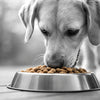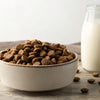Can You Store Dry Dog Food in the Fridge? A Comprehensive Guide to Dog Food Storage
- Houndsy
Table of Contents
- Introduction
- The Significance of Proper Dog Food Storage
- Best Practices for Storing Dry Dog Food
- Best Practices for Storing Wet Dog Food
- Can You Store Dry Dog Food in the Fridge?
- How to Tell If Your Dog Food Has Spoiled
- Enhance Your Dog Feeding Routine with Houndsy
- Conclusion
Introduction
As pet owners, we all want the best for our furry companions, and that includes ensuring they receive fresh and nutritious meals. Did you know that improper storage of dog food can lead to spoilage and even health risks for your pet? A recent study found that up to 20% of pet owners unknowingly feed their dogs spoiled food due to inadequate storage practices. This raises an important question: can you store dry dog food in the fridge?
In this blog post, we will explore the best practices for storing dry dog food and the implications of different storage methods on your dog's health and well-being. By the end, you’ll have a clear understanding of how to store dog food effectively while keeping it fresh and safe for your beloved pet.
We’ll cover the following topics:
- The significance of proper dog food storage
- Best practices for storing dry and wet dog food
- The pros and cons of refrigeration
- How to tell if your dog food has spoiled
- Tips for maintaining your dog’s feeding routine with innovative products like the Houndsy Kibble Dispenser
Let’s dive into the world of dog food storage and make sure our canine companions are eating the best!
The Significance of Proper Dog Food Storage
Proper storage of dog food is paramount for several reasons:
- Nutritional Integrity: Dog food can lose its nutritional value when exposed to air, moisture, and light. Vitamins and minerals degrade over time, making the food less beneficial for your pet.
- Prevention of Spoilage: Improper storage can lead to mold growth, rancidity, or bacterial contamination, all of which can cause serious health issues for dogs.
- Pest Control: Unsealed food can attract pests such as rodents and insects, further contaminating the food.
- Cost-Effectiveness: By storing dog food correctly, you can extend its shelf life, reducing waste and saving money.
Given these reasons, it’s crucial to follow recommended storage practices to ensure your dog’s food remains fresh and safe.
Best Practices for Storing Dry Dog Food
To maintain the quality of dry dog food, we recommend the following practices:
1. Keep It in the Original Packaging
Whenever possible, store dry dog food in its original packaging. The bag is designed to provide a barrier against air, moisture, and light. If you choose to transfer the food to another container, use a clean, airtight one, and make sure to keep the original bag inside it. This way, you’ll retain important information like expiration dates and batch numbers.
2. Airtight Containers
If you prefer using a separate container, opt for high-quality, airtight storage solutions. Containers made from stainless steel or BPA-free plastic are excellent choices. An airtight seal helps to minimize exposure to air, which can cause the fats in the kibble to go rancid.
3. Cool, Dry Storage Location
Store dog food in a cool, dry area of your home. The ideal temperature should not exceed 80°F (27°C). Areas like pantries or cupboards are generally suitable, while places like garages or sheds—especially in summer—should be avoided due to fluctuating temperatures.
4. Avoid Direct Sunlight
Keep dog food away from direct sunlight, which can contribute to spoilage. A dark, cool cupboard is ideal.
5. Use Within a Reasonable Time Frame
Once opened, dry dog food should ideally be used within six weeks to ensure freshness. Always check for expiration dates and adhere to them strictly.
Best Practices for Storing Wet Dog Food
Wet dog food requires different storage methods due to its moisture content:
1. Refrigerate After Opening
Once a can of wet dog food is opened, it should be stored in the refrigerator to prevent bacterial growth. Use a can cover or wrap the opened can with plastic wrap to maintain freshness. Make sure to consume the leftovers within 3 to 5 days.
2. Check for Spoilage
Before serving opened wet food, check for any signs of spoilage. If the food smells off, has an unusual texture, or shows signs of mold, discard it immediately.
3. Store Unopened Cans in a Cool, Dry Place
Like dry food, unopened cans of wet dog food should be kept in a cool, dry environment. Follow the expiration dates closely for the best quality.
Can You Store Dry Dog Food in the Fridge?
So, can you store dry dog food in the fridge? The answer is generally no. While refrigerating dry dog food might seem like a good way to extend its shelf life, it can actually introduce moisture into the food, which can lead to mold growth.
The ideal storage for dry dog food is in a cool, dry place at room temperature. However, if you live in a particularly hot and humid climate and feel that refrigeration is necessary, make sure to use an airtight container to prevent moisture from affecting the food.
How to Tell If Your Dog Food Has Spoiled
Keeping an eye on your dog food is essential for ensuring your pet’s health. Here are some signs that your dog food may have spoiled:
- Unpleasant Odor: If the kibble smells rancid or off, it’s best to discard it.
- Discoloration: Look for any unusual changes in color or texture of the kibble.
- Mold: Any visible signs of mold mean you should throw the food out immediately.
- Change in Consistency: If the kibble feels moist or sticky, it could indicate spoilage.
Enhance Your Dog Feeding Routine with Houndsy
At Houndsy, we understand that feeding your dog can sometimes feel like a chore, but it doesn’t have to be! Our flagship product, the Houndsy Kibble Dispenser, simplifies the feeding process while adding a touch of elegance to your home. With features like perfect portion control and a large storage capacity of 25-30 lbs, our dispenser helps you maintain consistency in your dog’s diet.
The Houndsy Kibble Dispenser is designed with convenience in mind. The ergonomic crank allows you to dispense kibble without bending down, and the auto-locking mechanism ensures that curious pets or toddlers can’t accidentally access the food. Plus, the mid-century modern design fits seamlessly into any home decor.
To learn more about how the Houndsy Kibble Dispenser can transform your dog feeding routine, check it out here.
Conclusion
In conclusion, proper storage of dog food is essential for maintaining its nutritional value and preventing spoilage. While refrigeration is not recommended for dry dog food, following best practices for storage can greatly enhance the quality of your pet’s meals. By keeping food in airtight containers, storing it in a cool, dry place, and being vigilant about spoilage, we can ensure our beloved dogs receive the best nutrition possible.
As responsible pet owners, let’s commit to enhancing our feeding routines. If you're looking to elevate your dog feeding experience, consider the innovative design and functionality of the Houndsy Kibble Dispenser.
FAQ
1. How long can I keep dry dog food?
Once opened, dry dog food should ideally be used within six weeks for optimal freshness.
2. Can I freeze dry dog food?
Yes, you can freeze dry dog food in airtight containers, but it’s generally not necessary unless you have a large quantity that you won’t use soon.
3. What are signs of spoilage in wet dog food?
Signs of spoilage in wet dog food include an off smell, mold, or changes in texture.
4. Is it safe to feed my dog expired food?
Feeding expired food is not recommended as it may pose health risks. Always check expiration dates and discard any expired food.
5. How does the Houndsy Kibble Dispenser work?
The Houndsy Kibble Dispenser features an ergonomic crank for easy dispensing, a large capacity for storage, and an auto-locking mechanism to keep food secure.
Let’s make mealtime enjoyable and safe for our furry friends!












